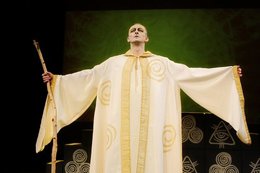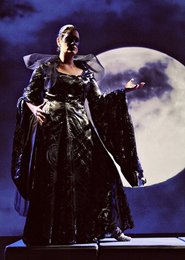The Magic Flute is in many ways a hybrid of an opera: as a ‘singspiel’ – a German comic opera – meant to entertain the middle and lower classes, it also highlights serious issues of enlightenment and the victory of reason over emotion (based on Masonic symbolism; Mozart himself was a member of a lodge in Vienna). Much ink has also been spilled over the fact that almost an hour into the opera the Queen of the Night – so far the piece’s wronged heroine – suddenly turns out to be the baddie who would even sacrifice her daughter to serve her selfish goals.
 Glasthule Opera’s production of Mozart’s final opera did not try to disentangle these paradoxes but rather let them clash to produce a piece of brilliant entertainment. Director Ian R. Walsh dispensed with the usual Egyptian backdrop and kept only the all-seeing eye (the triangle-framed eye known from the US one-dollar bill) as a Masonic symbol. The set was made of square boxes shifted around to indicate walls, portals or pedestals as required by the scene; half of the boxes were decorated with the all-seeing eye, the other half with the Celtic triple spiral best known from Newgrange. The eye would traditionally be associated with Sarastro, yet when he first appeared his cloak featured the spiral instead. This Magic Flute was thoroughly ‘celticised.’
Glasthule Opera’s production of Mozart’s final opera did not try to disentangle these paradoxes but rather let them clash to produce a piece of brilliant entertainment. Director Ian R. Walsh dispensed with the usual Egyptian backdrop and kept only the all-seeing eye (the triangle-framed eye known from the US one-dollar bill) as a Masonic symbol. The set was made of square boxes shifted around to indicate walls, portals or pedestals as required by the scene; half of the boxes were decorated with the all-seeing eye, the other half with the Celtic triple spiral best known from Newgrange. The eye would traditionally be associated with Sarastro, yet when he first appeared his cloak featured the spiral instead. This Magic Flute was thoroughly ‘celticised.’
Sung in English, the text is not a literal translation of the German libretto; Dublin’s Sarastro became the ‘Druid of the Sun’ while the final trials took place in front of a picture combining the Celtic monuments of Newgrange and Stonehenge. Whenever something serious or frightening was about to happen, Walsh defused the situation through laughter: the serpent threatening to kill Tamino was probably the cutest cuddly toy ever to feature in this role, while it was difficult to take Monostatos’ desire to rape, torture or murder seriously due to his appearance as a kind of display dummy come alive (clad from head to toe in a black suit without any hair or recognisable facial features). A secret star of the evening was Aidan Keane, in the programme listed only as ‘actor’, who not only oversaw the changes of scenery but also operated the serpent, acted as Monostatos’ enforcer, and as a human rabbit enchanted by Papageno’s magical glockenspiel, always displaying such a disarming combination of boredom and disdain that he became an instant favourite with the audience.
 One of Glasthule Opera’s principles is the support of young Irish singing talent; yet again there was much of it in evidence on this occasion. Katy Kelly negotiated the much-feared part of the Queen of the Night with aplomb, overwhelming friend and foe alike with her high-speed coloratura onrushes and piercing everybody with her peak notes particularly in the first of her two big arias. Equally impressive was Colette Boushell as Pamina, not only in her duet with Papageno but even more so through the emotional warmth and intelligent articulation in her ‘suicidal’ G minor aria. John Molloy lend his stentorian and majestic voice to the probably tallest and most dominating Sarastro I have seen yet; there could be no doubt that, come what may, he will always be in charge and never lose patience. Robert Duff painted Papageno in a more lyrical than vigorous colour and elicited some of the evening’s biggest laughs with his broad Irish dialect in the dialogue scenes (yet not his sung lines). Ross Scanlon’s Tamino enjoyed his part but was maybe sometimes a little bit overexcited in the delivery of his melodic peaks.
One of Glasthule Opera’s principles is the support of young Irish singing talent; yet again there was much of it in evidence on this occasion. Katy Kelly negotiated the much-feared part of the Queen of the Night with aplomb, overwhelming friend and foe alike with her high-speed coloratura onrushes and piercing everybody with her peak notes particularly in the first of her two big arias. Equally impressive was Colette Boushell as Pamina, not only in her duet with Papageno but even more so through the emotional warmth and intelligent articulation in her ‘suicidal’ G minor aria. John Molloy lend his stentorian and majestic voice to the probably tallest and most dominating Sarastro I have seen yet; there could be no doubt that, come what may, he will always be in charge and never lose patience. Robert Duff painted Papageno in a more lyrical than vigorous colour and elicited some of the evening’s biggest laughs with his broad Irish dialect in the dialogue scenes (yet not his sung lines). Ross Scanlon’s Tamino enjoyed his part but was maybe sometimes a little bit overexcited in the delivery of his melodic peaks.
Like the singers, the orchestral players faced a tough task in the unforgiving dry acoustics of the Pavilion Theatre that highlight any imperfection; this is even more true in the case of a Mozart score played by a reduced chamber orchestra with single strings and a brass section only represented by a horn. The orchestra – led by Alan Smale in brilliant, energetic form – mastered this challenge most convincingly. (It would be nice to have the players as well as the chorus members listed in the programme.) Occasionally one missed the gravitas the brass would provide – particularly in the opening chords and the act finales – yet by and large the reduction worked surprisingly well. This was to a large degree Andrew Synnott’s (baton and celesta) achievement; he guided singers and orchestra with a firm hand and elicited from his small band a unified, homogenous sound.
After the demise of Opera Ireland, the recent official burial of the National Irish Opera Company, and with Opera Theatre Company’s future in the balance, Glasthule Opera now plays an even more important part in Dublin’s cultural scene than ever before. Here is hoping that Anne-Marie O’Sullivan’s enterprise will continue to thrive and display Irish talent for many years to come.
Wolfgang Marx is lecturer at the UCD School of Music.